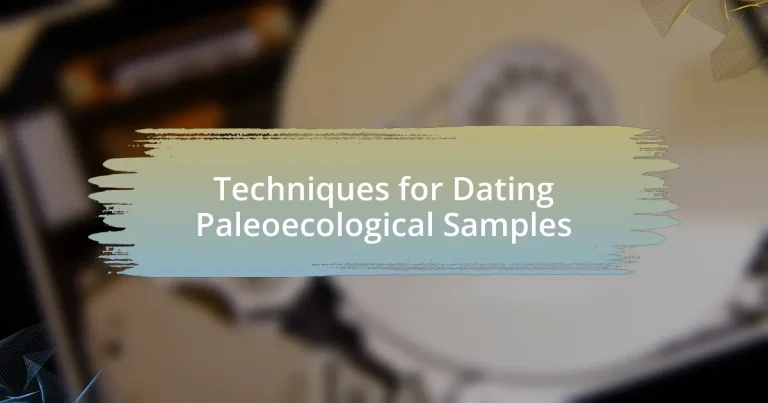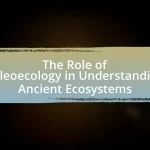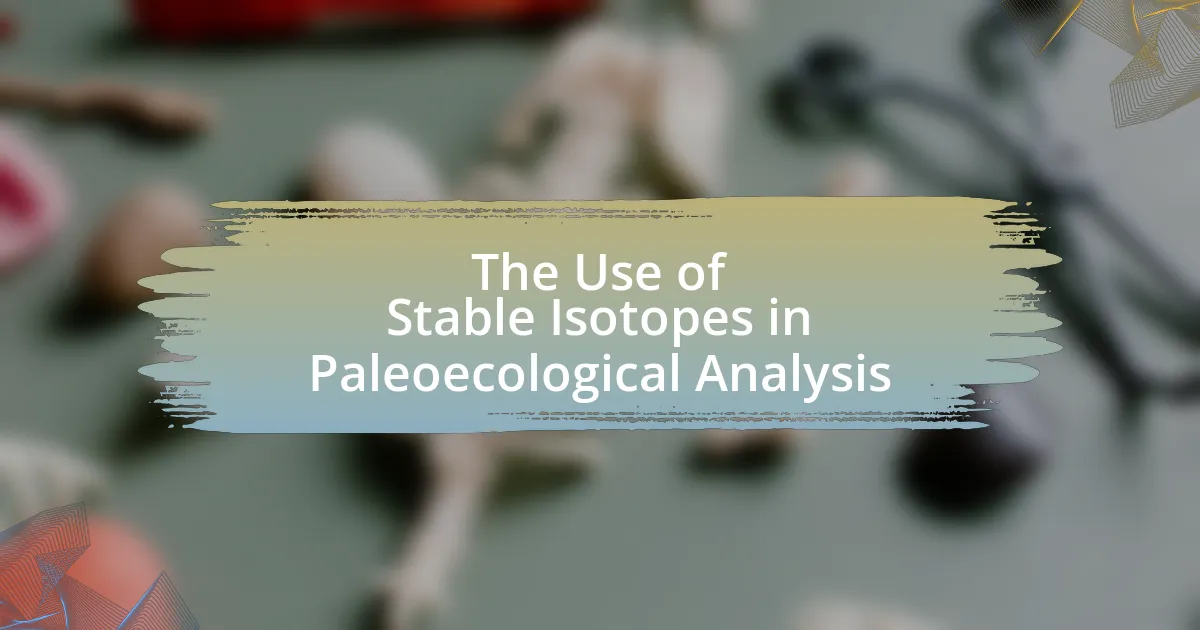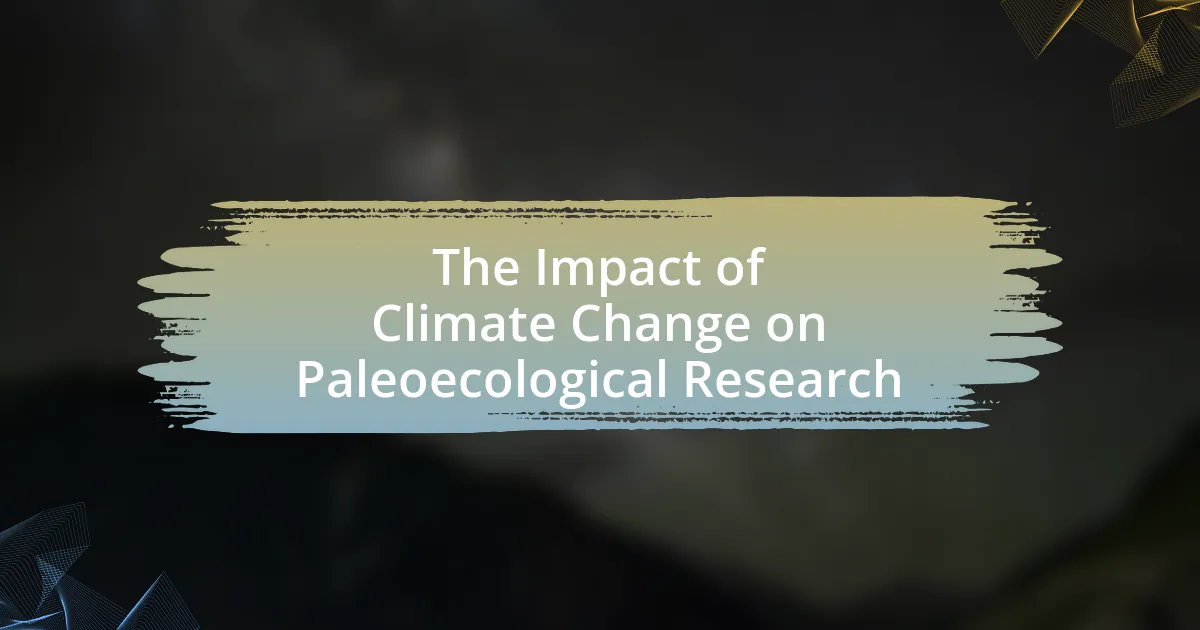Techniques for dating paleoecological samples are essential for reconstructing past environments and understanding ecological changes over time. Key methods include radiocarbon dating, which measures the decay of carbon-14 in organic materials; dendrochronology, which analyzes tree ring patterns; and luminescence dating, which determines when mineral grains were last exposed to light. Each technique has its strengths and limitations, influencing the choice of method based on sample type, age, and environmental context. Accurate dating is crucial for correlating ecological changes with global events, thereby enhancing our understanding of biodiversity dynamics and informing conservation strategies.

What are Techniques for Dating Paleoecological Samples?
Techniques for dating paleoecological samples include radiocarbon dating, dendrochronology, and luminescence dating. Radiocarbon dating measures the decay of carbon-14 in organic materials, providing age estimates up to about 50,000 years. Dendrochronology analyzes tree ring patterns to date events and environmental changes over the last several thousand years. Luminescence dating, including optically stimulated luminescence (OSL), determines the last time mineral grains were exposed to light, effectively dating sediments that can be thousands of years old. These methods are widely used in paleoecology to reconstruct past environments and understand ecological changes over time.
Why is dating paleoecological samples important?
Dating paleoecological samples is important because it allows researchers to establish the chronological framework of past environments and ecosystems. This chronological context is essential for understanding the timing and rates of ecological changes, such as species extinctions, climate shifts, and habitat transformations. Accurate dating enables scientists to correlate these changes with global events, such as volcanic eruptions or glacial cycles, providing insights into how ecosystems respond to environmental stressors. For instance, radiocarbon dating of organic materials from sediment layers can reveal when specific species thrived or declined, thus informing conservation strategies and enhancing our understanding of biodiversity dynamics over time.
What insights can dating provide about past environments?
Dating techniques can reveal critical insights about past environments by providing chronological frameworks for ecological changes. For instance, radiocarbon dating allows scientists to determine the age of organic materials, which helps reconstruct past climate conditions and vegetation patterns. This method has been instrumental in understanding shifts in ecosystems during events like the last glacial maximum, where data indicates significant changes in flora and fauna distribution. Additionally, dendrochronology, or tree-ring dating, offers precise annual records of climate variations, enabling researchers to correlate tree growth patterns with historical climate data. These dating methods collectively enhance our understanding of how past environments responded to climatic shifts and human activities, thereby informing current ecological studies and conservation efforts.
How does dating contribute to understanding ecological changes?
Dating contributes to understanding ecological changes by providing chronological frameworks that allow scientists to correlate biological and environmental data over time. Techniques such as radiocarbon dating and dendrochronology enable researchers to establish timelines for when specific ecological events occurred, such as species migrations or shifts in climate. For instance, radiocarbon dating of organic materials can reveal when certain plant or animal species thrived or declined, thus linking these changes to broader environmental shifts. This temporal context is crucial for interpreting how ecosystems respond to natural and anthropogenic influences, as evidenced by studies that show correlations between climate change and species distribution patterns over the last several millennia.
What are the main methods used for dating paleoecological samples?
The main methods used for dating paleoecological samples include radiocarbon dating, dendrochronology, and stratigraphy. Radiocarbon dating measures the decay of carbon-14 in organic materials, providing accurate dates for samples up to about 50,000 years old. Dendrochronology analyzes tree ring patterns to establish chronological sequences, allowing for precise dating of wooden samples. Stratigraphy involves studying sediment layers to determine the relative ages of fossils and artifacts based on their position within the geological record. These methods are widely accepted in the scientific community for their reliability and accuracy in dating paleoecological samples.
What is radiocarbon dating and how does it work?
Radiocarbon dating is a scientific method used to determine the age of organic materials by measuring the amount of carbon-14 they contain. This technique relies on the principle that carbon-14, a radioactive isotope, is formed in the atmosphere and absorbed by living organisms during their lifetime. When an organism dies, it stops taking in carbon-14, and the isotope begins to decay at a known rate, with a half-life of approximately 5,730 years. By measuring the remaining carbon-14 in a sample and comparing it to the initial levels in the atmosphere, scientists can estimate the time since the organism’s death, providing a reliable dating method for archaeological and geological samples up to about 50,000 years old.
What are the limitations of radiocarbon dating?
Radiocarbon dating has several limitations, primarily related to its age range, calibration issues, and contamination risks. The method is effective for dating organic materials up to about 50,000 years old; beyond this range, the amount of carbon-14 becomes too minimal to measure accurately. Additionally, calibration curves, which adjust radiocarbon dates to calendar years, can introduce uncertainties due to variations in atmospheric carbon levels over time. Contamination from modern carbon sources can also skew results, leading to inaccurate dating. These factors collectively limit the reliability and applicability of radiocarbon dating in paleoecological studies.
How does dendrochronology contribute to dating?
Dendrochronology contributes to dating by analyzing tree rings to determine the age of trees and the environmental conditions during each growth year. This method allows researchers to create a chronological timeline, as each ring corresponds to a specific year of growth, providing precise dating for wooden artifacts and historical events. For instance, the study of bristlecone pine trees has established a continuous record of climate data extending over 9,000 years, which can be correlated with archaeological findings to date human activity accurately.
What role does luminescence dating play in paleoecology?
Luminescence dating plays a crucial role in paleoecology by providing accurate age estimates for sedimentary deposits, which helps reconstruct past environmental conditions. This dating technique measures the last time mineral grains, such as quartz or feldspar, were exposed to sunlight or heat, allowing researchers to determine when sediments were deposited. For instance, studies have shown that luminescence dating can effectively date sediments from glacial, fluvial, and aeolian environments, thereby offering insights into climate changes and ecological shifts over time. By establishing a timeline for sediment deposition, luminescence dating aids in understanding the interactions between organisms and their environments throughout geological history.

How do different techniques compare in accuracy and application?
Different techniques for dating paleoecological samples, such as radiocarbon dating, dendrochronology, and luminescence dating, vary significantly in accuracy and application. Radiocarbon dating is highly accurate for organic materials up to about 50,000 years old, with a standard error of ±40 years for samples younger than 10,000 years, making it suitable for recent paleoecological studies. Dendrochronology, which analyzes tree rings, provides precise dating for the last several thousand years, with annual resolution, but is limited to regions with suitable tree species. Luminescence dating, including optically stimulated luminescence (OSL), can date sediments from thousands to several hundred thousand years, but its accuracy can be affected by environmental factors and requires careful sample collection. Each technique’s effectiveness depends on the specific context and age range of the samples being studied, highlighting the importance of selecting the appropriate method for accurate paleoecological reconstruction.
What factors influence the choice of dating technique?
The choice of dating technique in paleoecology is influenced by factors such as the type of material being dated, the age range of the sample, and the desired precision of the dating. For instance, radiocarbon dating is suitable for organic materials up to about 50,000 years old, while uranium-series dating is effective for dating calcium carbonate materials over longer timescales. Additionally, the environmental context and the specific research questions being addressed also play critical roles in determining the appropriate technique. For example, if a high-resolution chronological framework is needed, techniques like dendrochronology may be preferred due to their precision in dating tree rings.
How do sample type and age affect dating method selection?
Sample type and age significantly influence the selection of dating methods in paleoecological studies. Different materials, such as organic remains, sediments, or minerals, require specific techniques; for instance, radiocarbon dating is suitable for organic samples up to about 50,000 years old, while potassium-argon dating is used for volcanic materials that are millions of years old. The age of the sample also determines the method’s effectiveness; older samples may necessitate isotopic methods, while younger samples can often be dated using stratigraphic correlation or dendrochronology. Thus, the interplay between sample type and age directly dictates the appropriate dating technique to ensure accurate chronological assessments in paleoecological research.
What are the environmental considerations in choosing a technique?
Environmental considerations in choosing a technique for dating paleoecological samples include the potential impact on local ecosystems, the sustainability of the materials used, and the energy consumption associated with the technique. For instance, techniques that require extensive excavation or alteration of habitats can disrupt local flora and fauna, while methods that utilize non-renewable resources may contribute to environmental degradation. Additionally, energy-intensive techniques can lead to higher carbon footprints, which is a critical factor in assessing their overall environmental impact. Therefore, selecting a dating technique involves evaluating these factors to minimize ecological disruption and promote sustainability.
What are the advancements in dating techniques for paleoecological samples?
Advancements in dating techniques for paleoecological samples include the development of high-precision radiocarbon dating, improved luminescence dating methods, and the application of Bayesian statistical models. High-precision radiocarbon dating now allows for more accurate age estimates by utilizing accelerator mass spectrometry, which can measure isotopes with greater sensitivity. Improved luminescence dating techniques, such as optically stimulated luminescence (OSL), enable researchers to date sediment layers more effectively by measuring the last time mineral grains were exposed to light. Additionally, Bayesian statistical models enhance the interpretation of chronological data by integrating multiple dating methods and providing a more coherent timeline. These advancements collectively improve the reliability and accuracy of dating paleoecological samples, facilitating better understanding of past environmental changes.
How has technology improved the precision of dating methods?
Technology has significantly improved the precision of dating methods through advancements in radiocarbon dating, isotopic analysis, and dendrochronology. For instance, modern radiocarbon dating techniques utilize accelerator mass spectrometry (AMS), which allows for the measurement of carbon isotopes with greater accuracy and smaller sample sizes, enhancing the reliability of age estimates. Additionally, isotopic analysis, such as oxygen and strontium isotopes, provides more precise environmental context for dating, allowing researchers to correlate climatic events with biological changes. Dendrochronology has also benefited from technological improvements, including computer software that analyzes tree ring patterns more effectively, leading to more accurate dating of wood samples. These advancements collectively enable scientists to construct more reliable timelines of paleoecological events.
What new techniques are emerging in the field?
New techniques emerging in the field of dating paleoecological samples include advancements in radiocarbon dating, such as accelerator mass spectrometry (AMS), which allows for more precise measurements of carbon isotopes. This method significantly reduces sample size requirements and increases the accuracy of dating, enabling researchers to date samples that are thousands of years old with greater confidence. Additionally, the development of optically stimulated luminescence (OSL) dating has gained traction, allowing scientists to determine the last time sediment was exposed to light, thus providing insights into the timing of geological and ecological events. These techniques are validated by studies demonstrating their effectiveness in various environmental contexts, enhancing our understanding of past ecosystems and climate changes.
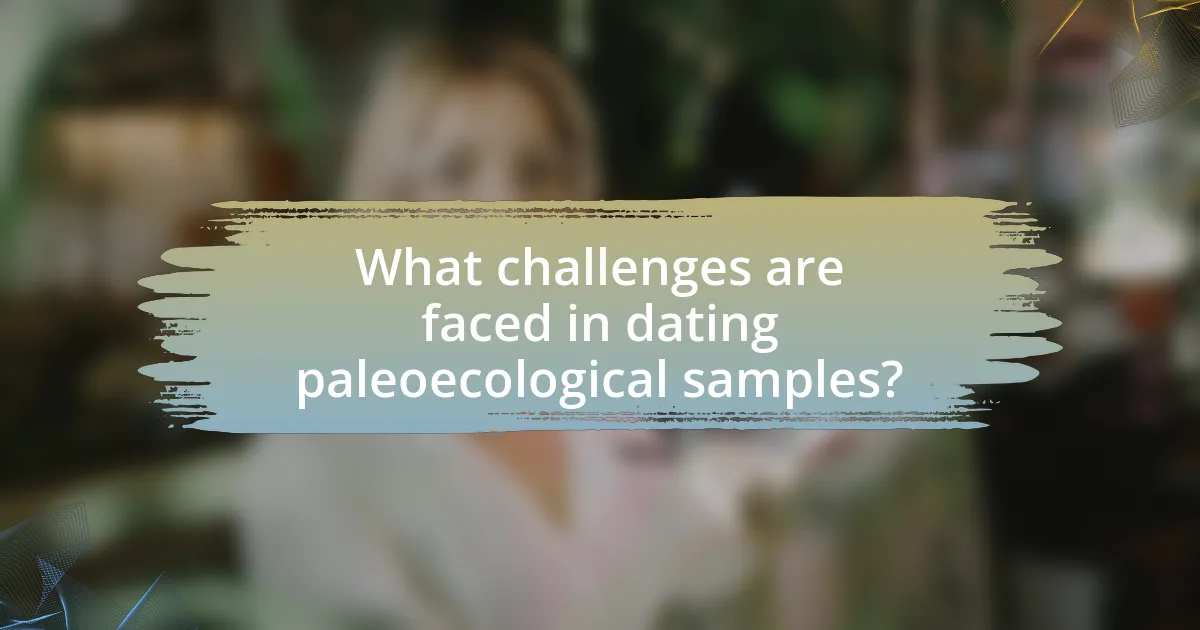
What challenges are faced in dating paleoecological samples?
Dating paleoecological samples faces several challenges, primarily due to the inherent complexities of the materials and the methods used. One significant challenge is the preservation state of the samples, as degradation over time can lead to loss of information and unreliable dating results. Additionally, contamination from modern materials can skew results, making it difficult to obtain accurate age estimates. Radiocarbon dating, a common method, is limited to samples younger than about 50,000 years, which restricts its applicability for older paleoecological contexts. Furthermore, the calibration of dating techniques can introduce uncertainties, as variations in atmospheric conditions and carbon reservoirs affect the accuracy of age determinations. These factors collectively complicate the dating process and necessitate careful consideration of methodologies and sample integrity.
What are common sources of error in dating methods?
Common sources of error in dating methods include contamination, calibration issues, and assumptions in decay rates. Contamination occurs when foreign materials alter the sample’s composition, leading to inaccurate age estimates. Calibration issues arise when the dating method’s reference standards do not align with the specific conditions of the sample, which can skew results. Additionally, assumptions regarding decay rates, such as those used in radiometric dating, may not account for environmental factors that can affect the rate of decay, resulting in further inaccuracies. These errors can significantly impact the reliability of dating paleoecological samples.
How do contamination and preservation affect dating accuracy?
Contamination and preservation significantly impact dating accuracy by introducing errors in the age estimation of paleoecological samples. Contamination occurs when foreign materials or organisms infiltrate a sample, potentially leading to misleading results; for instance, carbon dating can yield inaccurate ages if modern carbon is introduced into a sample. Preservation, on the other hand, affects the integrity of the sample over time; poorly preserved samples may degrade or lose essential components, which can skew dating results. Studies have shown that well-preserved samples yield more reliable dating outcomes, as evidenced by the consistent results obtained from samples stored in optimal conditions compared to those exposed to environmental factors.
What are the implications of dating errors on paleoecological research?
Dating errors in paleoecological research can lead to significant misinterpretations of ecological timelines and environmental changes. These inaccuracies can skew the understanding of species evolution, extinction events, and climate shifts, ultimately affecting the reconstruction of past ecosystems. For instance, if radiocarbon dating yields an erroneous age for a fossil, researchers may incorrectly correlate it with specific climatic events, leading to flawed hypotheses about species responses to environmental changes. Such implications can hinder the development of accurate models for predicting future ecological dynamics based on historical data.
How can researchers mitigate challenges in dating paleoecological samples?
Researchers can mitigate challenges in dating paleoecological samples by employing multiple dating techniques and cross-referencing results. For instance, using radiocarbon dating alongside dendrochronology can provide a more accurate age estimate, as radiocarbon dating is effective for organic materials up to about 50,000 years old, while dendrochronology can extend the timeline for more recent samples. Additionally, researchers can enhance the reliability of their findings by calibrating radiocarbon dates with known-age samples from the same region, which helps account for variations in atmospheric carbon levels over time. This multi-faceted approach not only improves accuracy but also allows for the identification of potential errors or anomalies in individual dating methods.
What best practices should be followed for sample collection?
Best practices for sample collection in paleoecological studies include using sterile tools, ensuring proper labeling, and maintaining consistent environmental conditions. Sterile tools prevent contamination, which is crucial for accurate dating and analysis. Proper labeling with detailed information about the sample location, date, and context aids in data integrity and traceability. Maintaining consistent environmental conditions, such as temperature and humidity, during collection and storage preserves the sample’s original state, which is essential for reliable results. These practices are supported by research indicating that contamination and improper handling can significantly skew dating results, as highlighted in studies on sediment core analysis and radiocarbon dating methodologies.
How can cross-validation with multiple techniques enhance reliability?
Cross-validation with multiple techniques enhances reliability by providing a more comprehensive assessment of model performance and reducing the risk of overfitting. When different validation methods, such as k-fold cross-validation and leave-one-out cross-validation, are employed, they allow for the evaluation of a model’s robustness across various subsets of data. This approach ensures that the model’s predictions are not solely dependent on a single dataset configuration, thereby increasing confidence in its generalizability. Studies have shown that using multiple cross-validation techniques can lead to more stable and accurate performance metrics, as evidenced by research in machine learning where models validated through diverse methods consistently outperform those validated through a single technique.
What practical tips can improve the dating of paleoecological samples?
To improve the dating of paleoecological samples, researchers should utilize multiple dating methods, such as radiocarbon dating and dendrochronology, to cross-verify results. This approach enhances accuracy by providing a range of dates from different techniques, reducing reliance on a single method that may have limitations. For instance, radiocarbon dating is effective for organic materials up to about 50,000 years old, while dendrochronology can provide precise annual dating for tree rings, allowing for correlation with climatic events. Additionally, careful sample selection and preparation are crucial; avoiding contamination and ensuring that samples are representative of the stratigraphic context can significantly improve dating reliability. Studies have shown that integrating these methods and maintaining rigorous sample integrity leads to more robust paleoecological timelines.
